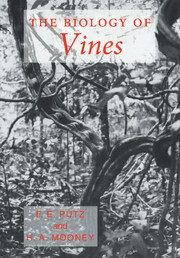Book contents
- Frontmatter
- Contents
- List of contributors
- Foreword
- Preface
- Acknowledgements
- I INTRODUCTION
- II CLIMBING MECHANICS AND STEM FORM
- III VINE PHYSIOLOGY AND DEVELOPMENT
- IV COMMUNITY ECOLOGY OF VINES
- 11 Distribution and abundance of vines in forest communities
- 12 Vines in arid and semi-arid ecosystems
- 13 Vine–host interactions
- 14 Seasonality of climbers: a review and example from Costa Rican dry forest
- 15 Breeding and dispersal systems of lianas
- V ECONOMIC IMPORTANCE OF VINES
- Taxonomic index
- General index
15 - Breeding and dispersal systems of lianas
Published online by Cambridge University Press: 05 November 2011
- Frontmatter
- Contents
- List of contributors
- Foreword
- Preface
- Acknowledgements
- I INTRODUCTION
- II CLIMBING MECHANICS AND STEM FORM
- III VINE PHYSIOLOGY AND DEVELOPMENT
- IV COMMUNITY ECOLOGY OF VINES
- 11 Distribution and abundance of vines in forest communities
- 12 Vines in arid and semi-arid ecosystems
- 13 Vine–host interactions
- 14 Seasonality of climbers: a review and example from Costa Rican dry forest
- 15 Breeding and dispersal systems of lianas
- V ECONOMIC IMPORTANCE OF VINES
- Taxonomic index
- General index
Summary
The organization and floristic composition of tropical plant communities is strongly and intricately influenced by interactions with pollinators and dispersers (Ashton, 1969; Frankie, 1975; Stiles, 1977, 1978; Gentry, 1982a, 1983; Frankie et al., 1983; Feinsinger, 1983; Bawa, Perry & Beach, 1985b). Data on tropical pollination and dispersal systems have begun to accumulate rapidly only in the last few years, but many of the available data have specifically excluded climbers. In this chapter I summarize what is known of climber reproductive biology from the literature, supplemented by my own observations and those of colleagues.
This chapter is a summary largely based on the liana subset of the data of Gentry (1982a, 1988, Chapter 1). These data are for plants > 2.5 cm dbh (2.5 cm greatest diameter for lianas) in 0.1 ha. The first half of the chapter summarizes pollination systems for the lianas and liana communities represented in these samples and compares them with pollination systems for other habit groups. The second half focuses on the dispersal strategies of these lianas and liana communities.
Tropical pollination systems are known to be highly diverse, with hummingbirds, perching birds, bees, hawkmoths, settling moths, bats, butterflies, wasps, flies, and beetles all known to play a role (Faegri & van der Pijl, 1966; Baker, 1973; Bawa et al., 1985a). Knowledge of the diversity of tropical pollination systems continues to increase, most recently with nonflying mammals (Lumer, 1980; Janson, Terborgh & Emmons, 1981; Steiner, 1981) and thrips (Ashton, 1979; Thien, 1980; Appanah & Chan, 1981) discovered to play significant roles.
- Type
- Chapter
- Information
- The Biology of Vines , pp. 393 - 424Publisher: Cambridge University PressPrint publication year: 1992
- 9
- Cited by



